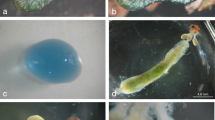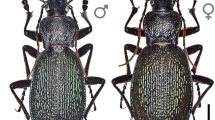Abstract
Cantharidin contents were determined in several canthariphilous insects by means of quantitative gas chromatography. Usually the ceratopogonidsAtrichopogon oedemerarum andA. trifasciatus caught in the field contained low concentrations of cantharidin, with concentrations in males, in most cases, being lower than in females. When fed in the laboratory with synthetic cantharidin, these species concentrated cantharidin by as much as 100-fold (males) and 40-fold (females). Accumulation in the different body tagmata (head, thorax, abdomen) of these species is similar. Maximal concentrations of cantharidin in tissues ofAtrichopogon are comparable to those known from oedemerid and meloid beetles. InA. trifasciatus about 90% of total cantharidin content is bound in tissues. Investigations using the canthariphilous anthomyiid flyAnthomyia pluvialis and three cantharidin-producing oedemerid species revealed the same pattern of distribution in different body tagmata as inAtrichopogon.
Similar content being viewed by others
References
Boppré, M. 1986. Insects pharmacophagously utilizing defensive plant chemicals (pyrrolizidine alkaloids).Naturwissenschaften 73:17–26.
Capinera, J.L., Gardner, D.R., andStermitz, F.R. 1985. Cantharidin levels in blister beetles (Coleoptera: Meloidae) associated with Alfalfa in Colorado.J. Econ. Entomol. 78:1052–1055.
Carrel, J.E., andEisner, T. 1974. Cantharidin: Potent feeding deterrent to insects.Science 1983:755–757.
Carrel, J.E., Doom, J.P., andMcCormick, J.P. 1985. Quantitative determination of cantharidin in biological materials using capillary gas chromatography with flame ionisation detection.J. Biol. Chem. 342:411–415.
Carrel, J.E., Doom, J.P., McCormick, J.P. 1986. Identification of cantharidin in false blister beetles (Coleoptera, Oedemeridae) from Florida.J. Chromatogr. 12:741–747.
Dixon, A.F.G., Martin-Smith, M., andSmith, S.J. 1963. Isolation of cantharidin fromMeloe proscarabeus.Can. Pharm. J. Sci. Sect. 96:501–503.
Downes, J.A. 1971. The ecology of blood-sucking diptera: An evolutionary perspective, pp. 232–257,in A.M. Fallis (ed.). Ecology and Physiology of parasites. A. Hilger, London.
Eisner, T. 1988. Insekten als fürsorgliche Eltern.Verh. Dtsch. Zool. Ges. 81:9–17.
Eisner, T., Conner, J., Carrel, J.E., McCormick, J.P., Slagle, A.J., Gans, C., andO'Reilly, J.C. 1990. Systemic retention of ingested cantharidin by frogs.Chemoecology 1:57–62.
Frenzel, M., Dettner, K., Wirth, D., Waibel, J., andBoland, W. 1992. Cantharidin analogues and their attractancy for ceratopogonid flies (Diptera: Ceratopogonidae).Experientia 48:106–111.
Gad, A.M. 1951. The head-capsule and mouth-parts in the Ceratopogonidae.Bull. Soc. Entomol. Egypt 35:17–75.
Görnitz, K. 1937. Cantharidin als Gift und Anlockungsmittel für Insekten.Arb. Physiol. Angew. Entomol. 4:116–157.
Graziano, M.J., Pessah, I.N., Matsuzawa, M., andCasida, J.E. 1988. Partial characterisation of specific cantharidin binding sites in mouse tissues.Mol. Pharmacol. 33:706–712.
Havelka, P. 1978.Atrichopogon lucorum (Meigen, 1818) (Diptera, Ceratopogonidae)—Ein neuer temporärer, canthariphiler Ektoparasit am ÖlkäferMeloe violaceus Mrsh., 1802 (Coleoptera, Meloinae).Z. Arbeitsgem. Öesterr. Entomol. 30:117–119.
Mayer, D.F., andJohansen, C.A. 1977. Cantharidin fromMeloe niger Kirby.Pan-Pac. Entomol. 53:101–103.
McCormick, J.P., andCarrel, J.E. 1987. Cantharidin biosynthesis and function in meloid beetles, pp. 307–350,in G.D. Prestwich, G.L. Blomquist (edts.). Pheromone Biochemistry. Academic Press, Orlando.
Megahed, M.M. 1956. Anatomy and histology of the alimentary tract of the female of the biting midgeCulicoides nubeculosus Meigen (Diptera: Heleidae=Ceratopogonidae).Parasitology 46:22–47.
Ray, A.C., Tamulinas, S.H., andReagor, J.C. 1979. High pressure liquid chromatographic determination of cantharidin, using a derivatisation method in specimens from animals acutely poisened by ingestion of blister beetles,Epicauta lemniscata.Am. J. Vet. Res. 40:498–504.
Schütz, C., andDettner, K. 1992. Cantharidin-secretion by elytral notches of male anthicid species (Coleoptera: Anthicidae).Z. Naturforsch. 47c:290–299.
Sierra, J.R., Woggon, W.-D., andSchmid, H. 1976. Transfer of cantharidin during copulation from the adult male to the femaleLytta vesicatoria (“Spanish flies”)Experientia 32:142–143.
Steyn, J.M., andHundt. H.K.L. 1988. Gas chromatographic-mass spectrometric method for the quantitation of cantharidin in human serum.J. Chromatogr. 432:177–184.
Weidner, H. 1990. Die Nutzbaren Insekten. Wolfgang-Siegel-Stiftung, Hof.
Author information
Authors and Affiliations
Rights and permissions
About this article
Cite this article
Frenzel, M., Dettner, K. Quantification of cantharidin in canthariphilous ceratopogonidae (Diptera), anthomyiidae (Diptera) and cantharidin-producing oedemeridae (Coleoptera). J Chem Ecol 20, 1795–1812 (1994). https://doi.org/10.1007/BF02066223
Received:
Accepted:
Issue Date:
DOI: https://doi.org/10.1007/BF02066223




